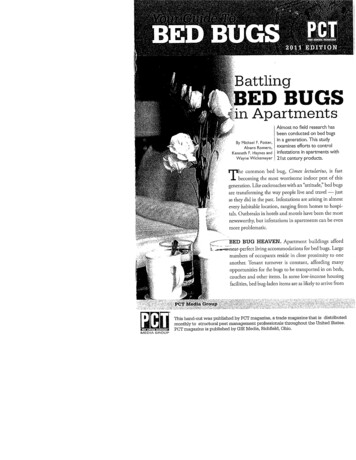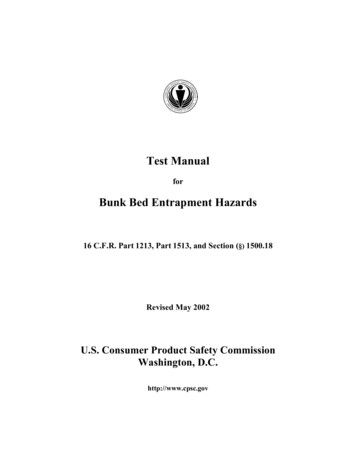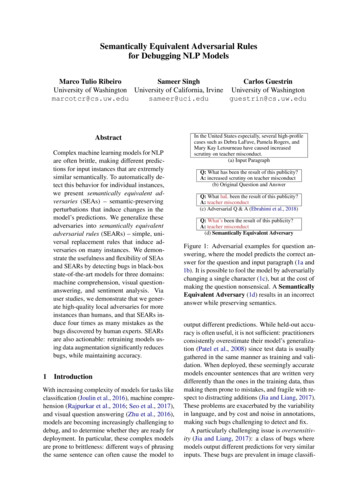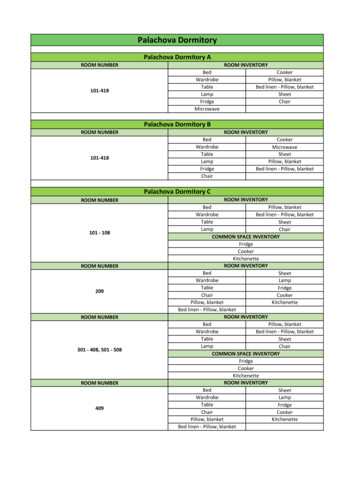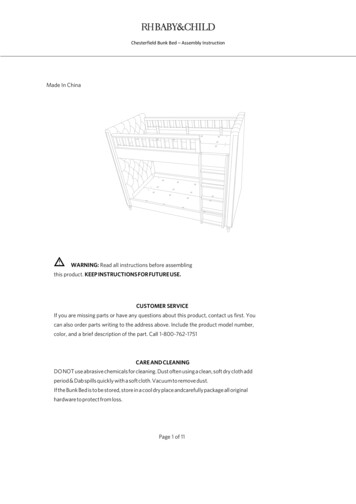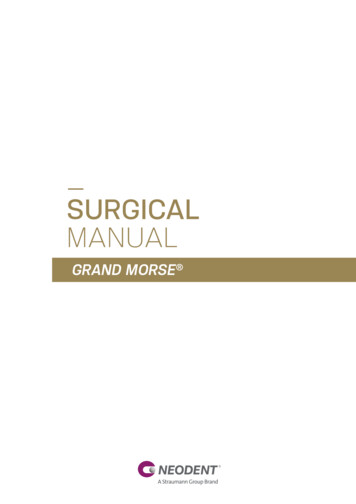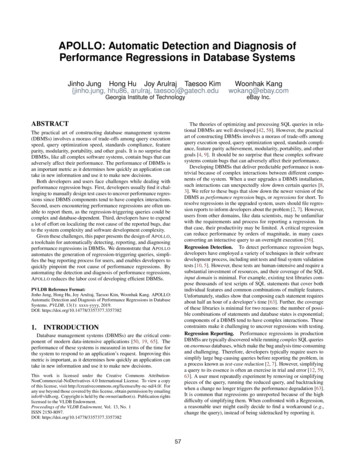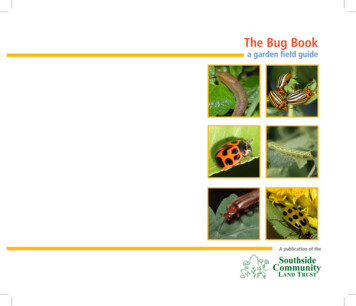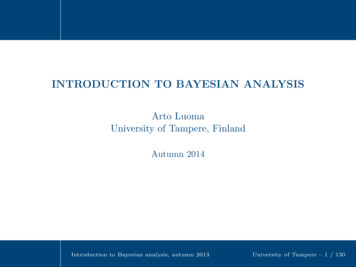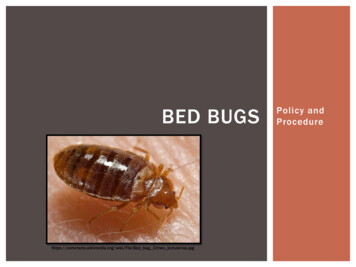
Transcription
BED BUGShttps://commons.wikimedia.org/wiki/File:Bed bug, Cimex lectularius.jpgPolicy andProcedure
MEET THE BED BUG Six months after the introduction of one mated,female bed bug into a location, an infestationscenario could look something like this: 121,409 nymphs 7,848 adults 169,490 bites Other information to know: Female bed bugs will lay between one andfive eggs a day. Eggs hatch in 6-15 days, depending on thetemperature. Each developmental stage lasts about 1week. Six weeks after hatching, a female could beready to mate and start the cycle /bed-bugs/Bed bugs are not known to transmit diseases tohumans.
MEET THE BED le.html#diagram
IS IT A BED BUG?Baby German Cockroach Bed bugs can look very much like baby Germancockroaches or bat bugs. If the bug you are looking at is dark brown/blackwith a lighter spot, it is a German cockroach. Bat bugs have more and longer hair than bedbugs, but this will be very difficult to see withthe naked eye. If you find any of these bugs in an item, or anyother bugs that are suspicious, follow the bed bugprocedures.Photo -pest library-28.php
6 STEPS OF A BED BUG INTRODUCTION1. Identification of a bed bug or bug damage2. Quarantine3. Inspection4. Treatment5. Follow-up with patron (including suspension of privileges, if applicable)6. Reinstatement of privileges
STEP 1: IDENTIFICATIONThere are several scenarios staff might encounter: Items with live bugs returned at the counter, where the bugs are discovered at the check-in desk orfront desk Items with live bugs returned in the book drop, possibly overnight Items with damage (or dead bugs), where the damage is discovered at the check-in desk or frontdesk Items with live bugs discovered after check in, where they have made it onto a book cart or theshelf Items with damage (or dead bugs) discovered after check in, where they have made it onto a bookcart or the shelf Furniture found with live or dead bugs or bed bug skins
STEP 1: IDENTIFICATION CONT’DExamples of bugs and damage in books:Look for live or dead bugs, bloodspots/smears, feces (small black dots), andshed skinshttp://bedbugschicago.blogspot.com/2014 03 01 archive.htmlhttps://www.slideshare.net/isl station
MORE EXAMPLES OF BED BUG DAMAGE
STEP 2: QUARANTINE If you find evidence of bed bugs in an item, immediately double bag the item with plastic bags (found on the topshelf in check-in area). Make sure the bags are sealed tightly. DO NOT MOVE THE ITEM as you risk having bugsfall off onto the floor or other surfaces. Spray down the area where bugs/evidence were found (counter, book drop bin, floor around the area, etc.) withEcoRaider Bed Bug Killer. There is a bottle of this at each desk. The spray is non-toxic but kills all stages of bedbug life immediately. Cont’d on next slide
STEP 2: QUARANTINE CONT’D Fill out a damage form with the date and your initials. If the item has already been checked in, be sure to add thename of the patron who returned it, if known. (See example on next slide). Tape the form to the outside of the bags. Change the item status in KOHA to “Workroom.” Inform the LOD that you have found evidence of bugs, they can help you follow the procedures and make sureeverything is quarantined correctly.
EXAMPLE OF DAMAGE FORM
STEP 2: QUARANTINE CONT’D Use the chart on the next slide to determine if more items need to be inspected and/or bagged. This chart willbe posted at check-in. When checked-in items come up on hold for Workroom Card, immediately follow the above quarantineprocedure. Brenda will send a letter to the patron informing them of the situation. Items with obvious damage that willcause us to throw the item away will be charged to the patron’s account as soon as possible. These items willbe discarded immediately after the letter is sent to minimize the risk of spreading the bugs around the library. Items that might be saved will be treated in the bed bug oven.
STEP 2: QUARANTINE CONT’DWhere evidence is foundType of EvidenceLive BugsDead Bugs, Damage, or SkinsFront Desk(Items are handed to you by the patron)Quarantine all items returned by thatperson/family (everyone at the sameaddress).Quarantine all items returned by thatperson/family (everyone at the sameaddress).Check-in deskQuarantine all items returned by thatperson/family (everyone at the sameaddress). Inspect all items in the bin;quarantine suspicious items. Also checkdrive-thru bins if items were returned there.Quarantine all items returned by thatperson/family (everyone at the sameaddress). Inspect all items in the bin;quarantine suspicious items. Also checkdrive-thru bins if items were returned there.Book Drop(Inside or drive-thru drops)Quarantine everything in the book drop –bugs may have transferred to other items.Inspect everything in the book drop,quarantine suspicious items.Book Cart or ShelfInspect everything on cart or shelf,quarantine suspicious items.Inspect everything on cart or shelf,quarantine suspicious items.FurnitureLet supervisor or LOD know immediately.Quarantine in place; do not move furniture.Let supervisor or LOD know immediately.Quarantine in place; do not move furniture.
TALKING POINTS FOR DISCUSSING WITHPATRONSIf you find evidence of bugs while the patron is still standing at the desk (i.e. watching you check in their items), beprepared to address the situation: Have the patron step aside with you and discreetly tell them it looks like there may be bed bugs or bed bugdamage in the items. Ask if they have had any problems with bed bugs in their home, or if they may have neighbors with a bugproblem (if they live in multi-family housing). Explain that in order to maintain the health and safety of the library’s materials and other patrons, borrowingprivileges will need to be suspended until they can provide a receipt or letter stating their home has beeninspected or treated. Inform the patron they may be charged if there is damage to materials. If you’re uncomfortable having this conversation or the patron becomes angry, get an LOD for help.
STEP 3: INSPECTION Brenda and/or other staff will inspect the items to determine if there is permanentdamage, or if treating the items in the bed bug oven will be sufficient. Check inside covers, between pages, and under book jackets or DVD covers. Items with permanent damage that will need to be thrown away will be charged to thepatron’s account as soon as possible. Brenda will send a letter to the patron explaining the situation.
STEP 4: TREATMENT Everyone will be trained on using the bed bug oven. A different person or small group will beassigned each month to running the bed bug oven when the need arises. It can take several hours for the oven to get hot enough, so make sure you check on itperiodically. It needs to be at least 122 degrees for 1 minute to kill all bed bug life. Don’t startitems in the oven less than 4 hours before closing. Be sure the oven is unplugged before the library closes. There is an instruction booklet kept on the counter next to the oven. Please read through it anduse it if you have questions, or ask Elle.
STEP 5: FOLLOW UP WITH PATRON ANDSTEP 6: REINSTATEMENT OF PRIVILEGES Treated items will be carefully inspected again for damage before returning them to thecollection. Any that are found to be permanently damaged will be charged to the patron. A damage letter will be sent to the patron informing them of the damaged items and the totalcharges. As soon as the patron brings in a letter or receipt from a pest control company stating their homehas been inspected and/or treated for bed bugs, their borrowing privileges can be restored.Please let the LOD know when this happens.
FINAL TIPS Remember to be discreet and polite if you need to speak to a patron about bed bugs. Bed bugs can beanywhere and anyone can get them! If you are ever worried about bringing bugs home with you, put your clothes in the dryer on high for onehour as soon as you get home to kill all stages of bed bug life. Remember to be on the lookout for signs of bugs when you are working at the check-in desk or front desk.Look inside covers and between pages. Even a small dot on the page edges can be evidence of worsedamage inside the book. If in doubt about an item, bag it! It’s better to be over-careful than to miss bugs and have them end up onthe shelf where they can spread to other items.
MEET THE BED BUG Six months after the introduction of one mated, female bed bug into a location, an infestation scenario could look something like this: 121,409 nymphs 7,848 adults 169,490 bites Other information to know: Female bed bugs will lay between one and fiv
